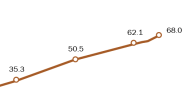Mapping the Global Muslim Population
Middle East-North Africa Overview
Table of Contents
- Mapping the Global Muslim Population
- Asia-Pacific Overview
- Middle East-North Africa Overview
- Sub-Saharan Africa Overview
- Europe Overview
- Americas Overview
- Interactive Data Table: World Muslim Population by Country
- Interactive Data Table: World Muslim Population by Region
- Methodology for Muslim Population Estimates
- Methodology for Sunni-Shia Estimates
- Data Sources by Country
- About this Report

The Middle East-North Africa region, which includes 20 countries and territories, is home to an estimated 315 million Muslims, or about 20% of the world’s Muslim population. Of these, approximately 79 million live in Egypt, meaning that about one-in-four (25%) Muslims in the region live in Egypt.
More than half the countries in the Middle East-North Africa region have populations that are approximately 95% Muslim or greater. These include Algeria, Egypt, Iraq,1 Jordan, Kuwait, Libya, Morocco, Palestinian territories, Saudi Arabia, Tunisia, Western Sahara and Yemen. Other countries in the region also have populations with a high percentage of Muslims, including Syria (92%), Oman (88%), Bahrain (81%), Qatar (78%), United Arab Emirates (76%) and Sudan (71%). Although most of the citizens of the Persian Gulf countries of Oman, Bahrain, Qatar and United Arab Emirates are Muslim, these countries have a substantial number of non-Muslim workers who are not citizens; this brings down the total percentage of their populations that is Muslim.
North Africa is home to the three largest Muslim populations in the Middle East-North Africa region: Egypt (79 million), Algeria (34 million) and Morocco (32 million). Other countries in the region with large Muslim populations include: Iraq (30 million), Sudan (30 million), Saudi Arabia (25 million), Yemen (23 million), Syria (20 million) and Tunisia (10 million). The population of the remaining 11 countries and territories in the region – Libya, Jordan, Palestinian territories, United Arab Emirates, Kuwait, Lebanon, Oman, Israel, Qatar, Bahrain and Western Sahara – totals about 31 million.
The Palestinian territories are home to about 4 million Muslims. In addition, Israel is home to roughly 1 million Muslims, slightly more than Qatar. Although Israel has a Muslim population similar in size to those of some western European countries, Muslims constitute a much larger portion (about 17%) of its population. By comparison, the United Kingdom is home to between 1 million and 2 million Muslims, about 3% of its total population.
Countries in the Middle East-North Africa with the Largest Number of Muslims
| Estimated 2009Muslim Population | Percentage ofPopulation thatis Muslim | Percentage ofWorld MuslimPopulation | |
|---|---|---|---|
| Egypt | 78,513,000 | 94.6% | 5.0% |
| Algeria | 34,199,000 | 98.0 | 2.2 |
| Morocco* | 31,993,000 | ~99 | ~2 |
| Iraq* | 30,428,000 | ~99 | ~2 |
| Sudan | 30,121,000 | 71.3 | 1.9 |
| Saudi Arabia* | 24,949,000 | ~97 | ~2 |
| Yemen | 23,363,000 | 99.1 | 1.5 |
| Syria | 20,196,000 | 92.2 | 1.3 |
| Tunisia | 10,216,000 | 99.5 | 0.7 |
| Libya | 6,203,000 | 96.6 | 0.4 |
| Jordan | 6,202,000 | 98.2 | 0.4 |
| Rest of Region | 18,937,000 | 65.7 | 1.2 |
| Regional Total | 315,322,000 | 91.2 | 20.1 |
| World Total | 1,571,198,000 | 22.9 | 100.0 |
| * Data for Morocco, Iraq and Saudi Arabia come primarily from general population surveys, which are less reliable than censuses or large-scale demographic and health surveys for estimating minority-majority ratios (see Methodology). As a result, the percentage of the population that is Muslim in these three countries is rounded to the nearest integer.Note: Figures may not sum to totals due to rounding. Pew Research Center’s Forum on Religion & Public Life • Mapping the Global Muslim Population, October 2009 | |||
Map: Distribution of Muslim Population in Middle East-North Africa
Roll over a country bubble to see its estimated 2009 Muslim population, the percentage of its population that is Muslim and the percentage of the world Muslim population it represents.
[embeded: src=”https://assets.pewresearch.org/wp-content/uploads/sites/11/2009/10/I_mena_map.swf” width=”560″ height=”360″ ]
* Indicates the use of a source with a small enough sample size to make these estimates somewhat less reliable. Due to this greater margin of error, percentages are rounded to the nearest integer rather than to the first decimal place and are therefore more approximate (~).
1 In Iraq and Afghanistan (Asia-Pacific), foreign military personnel or others associated with ongoing military and humanitarian operations are not included in the population estimates.
Sign up for our weekly newsletter
Fresh data delivered Saturday mornings
Related
Most Popular
Report Materials
Table of Contents
- Mapping the Global Muslim Population
- Asia-Pacific Overview
- Middle East-North Africa Overview
- Sub-Saharan Africa Overview
- Europe Overview
- Americas Overview
- Interactive Data Table: World Muslim Population by Country
- Interactive Data Table: World Muslim Population by Region
- Methodology for Muslim Population Estimates
- Methodology for Sunni-Shia Estimates
- Data Sources by Country
- About this Report




